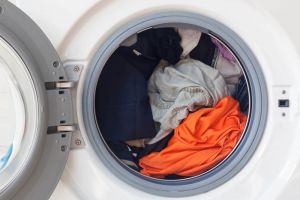Whether you like to dress up or down, white clothes are a wardrobe staple and a timeless choice that affords endless outfit opportunities. On the flip side, washing white clothes, and trying to keep them white, can make your head spin! That’s why we’ve put together a list of tips and tricks to help make the process ‘loads’ less stressful.
Washing white clothes and how to get the best results
White clothes tend to turn yellow over time due to a combination of dirt, sweat, and chemicals from deodorant but lucky for us, there are plenty of ways to revive and make them bright white again! Check out these easy steps below:
1. Treat stains as they arise
By spot-treating new stains when they happen, you are clearing the stain before it gets a chance to set. To do this, apply a stain remover to immediately target the mess. This will clear up the stain with enzymes that break apart the stain molecules. Stain removers come in many different formats such as sprays, gels, powders, etc. It’s recommended to fully wash the clothing after spot treating.
The only thing to keep in mind with stain removers is that they shouldn’t be used on delicate materials such as silk, velvet or leather – these need to be dry cleaned by a professional to ensure the fabric does not get damaged.
2. Separate whites from colours
Make sure to separate your white laundry from brightly coloured or dark clothing. If washed together, there is the risk of colour bleeding and transfer which not only turns your whites into an assortment of colours but leaves dark washing looking dull as well. So, all around, not an ideal situation to be in, especially when the alternative is so simple.

3. Avoid overloading
Doing the laundry is no walk in the park, so it’s understandable most people want to get it over with as quickly as possible but remember that overloading your washing machine is not the way to go. When your machine is overloaded, there’s not enough room between garments for the water and washing detergent to target dirt and grime effectively, which can leave clothes looking dull and even grey. For reference, your largest load of washing should only take up three-quarters of the tub.
4. Pick the right detergent
Use a liquid washing detergent specially designed for white clothes (powder detergents can leave residue on clothes). The key to picking the right detergent is to take a look at the list of ingredients. You’re looking for active ingredients like surfactants and enzymes. Surfactants work by lifting the soil away from the fabric and enzymes help to remove stains. Distilled white vinegar is also a great whitening and brightening booster you can add to your washing.
Read more: Laundry powder or liquid: Which should you use?
5. Avoid fabric softener
Fabric softener can cause residue build-up in your washer which in turn can cause your white clothes to turn grey over time. It’s best to use a mixture of baking soda and distilled white vinegar (add a cup to the stain remover compartment) which together work as a natural clothes brightener.
At what temperature should you wash white clothes?
Generally speaking, white clothes are best washed in warm to hot water (40˚C-60 ˚C) to keep them looking pristine. However, it’s also important to double-check washing instructions on the garment care label to check the hottest water temperatures the fabrics you’re washing can withstand. Some materials, such as cotton, can tolerate higher temperatures however polyester blends are best in lukewarm water.
There are several reasons to adjust the temperature on your washing machine to achieve the best wash. For example, fabric that’s significantly soiled will require a hotter temperature than fabric that is not. However, stains such as protein-based stains (such as blood stains) require a cold wash to help remove discolouration.
How do you keep white clothes white without bleach?
You can whiten your laundry with bleach-free alternatives such as baking soda, distilled white vinegar, and hydrogen peroxide (a mild form of oxygen bleach). You can add these natural alternatives to your wash cycle or use them as a pre-soak. It’s even been suggested that by drying your clothes outside in the sun, the UV rays will help to keep them white! While chlorine bleach can be an effective solution to remove stains from your white clothes, it may not react well with detergents and can even result in white clothes looking more yellow.
Read more: Your guide on how to clean white shoes
Washing white clothes in the washing machine
Some modern washing machines have a ‘whites setting’ designed ‘bleachable whites’ such as plain T-shirts, gym socks, underwear, tablecloths, etc. This wash setting dispenses bleach at the optimal time during the washing cycle and uses a vigorous spin for the best clean. This program can be used with or without bleach. If your machine doesn’t have this setting, a warm cycle with the right detergent will work just fine!
Read more: Washing machine cycles explained
How to sort and wash colours and dark clothes
It’s best to wash ‘dark colours’ on their own and keep the lighter colours for a different load. This is because, similar to whites, lighter colours also run the risk of colour transfer, turning your once light blue shirt into a striking purple. In the ‘light colours’ pile, you can include white items with labels or designs as well as light colours such as pastel pinks, purples, blues, etc. Dark colours include clothes that are black, navy, dark blue/grey/purple, maroon, etc. If you have the time, you can separate out bright colours such as reds and yellows as they are the most likely colours to bleed in the wash, but if not put them in with the dark clothes.
Read more: How do I clean my washing machine?
Do I have the right washing machine for my clothes
Having a washing machine that can clean your clothes without damaging them will come down to the functions and settings it has. If you own an array of clothing that are different colours, fabrics and quantities having a washing machine that can accommodate them all is ideal. A machine that can wash cotton, delicates, sheets, wool and other materials can be helpful but a machine that can also allow you to adjust the temperature, spin speed and even the detergent dosing means you can cater a load to suit your needs. If you’re after a new machine that has more features, compare brands below to get started.




Share this article